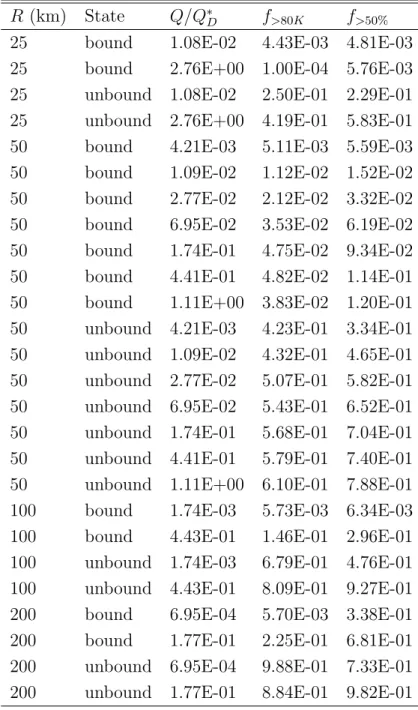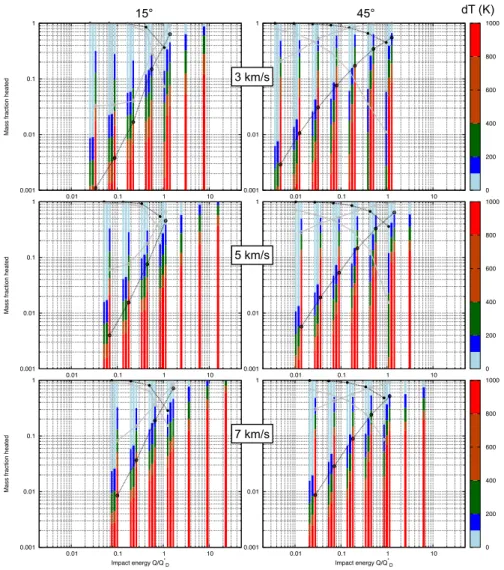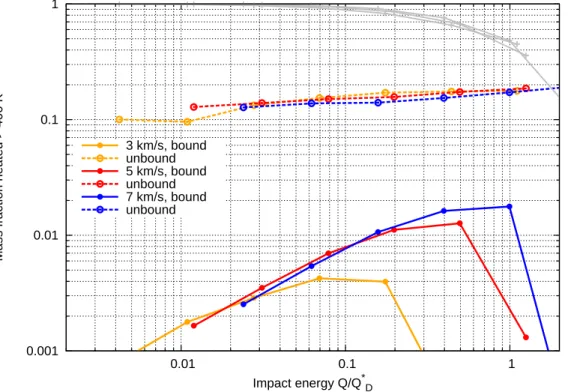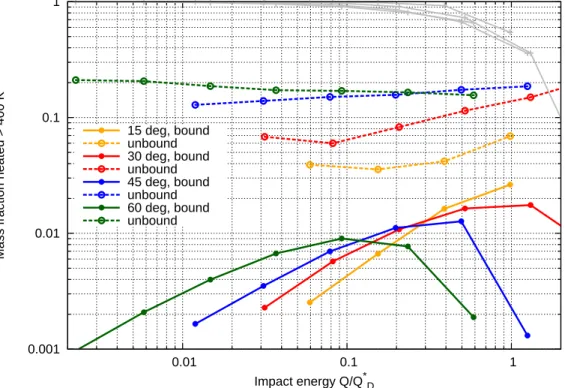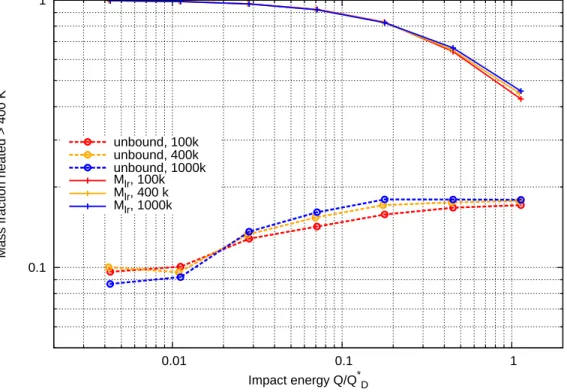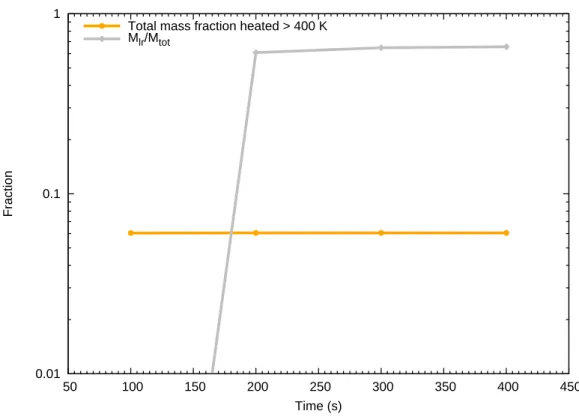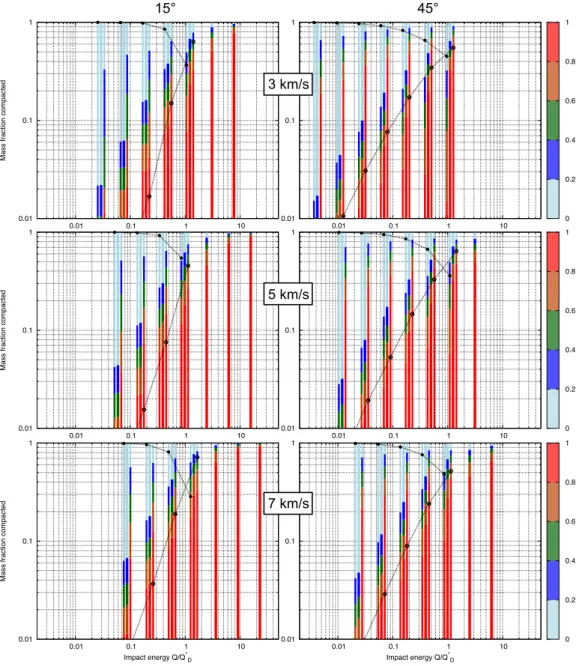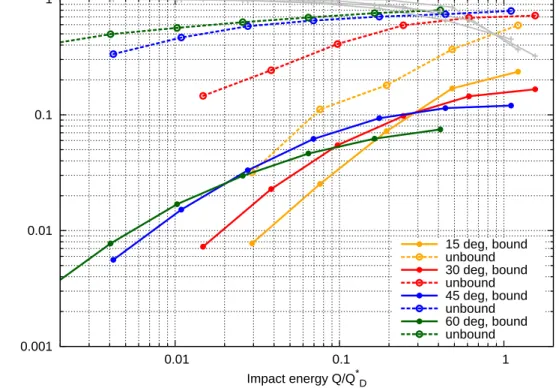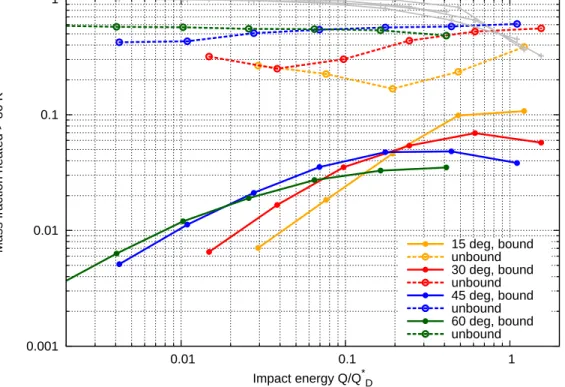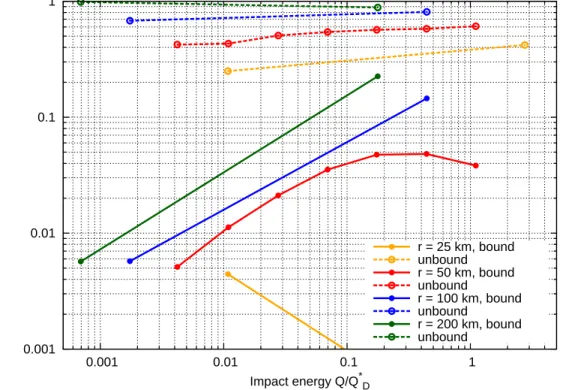HAL Id: hal-02986173
https://hal.archives-ouvertes.fr/hal-02986173
Submitted on 21 Dec 2020
HAL is a multi-disciplinary open access archive for the deposit and dissemination of sci-entific research documents, whether they are pub-lished or not. The documents may come from
L’archive ouverte pluridisciplinaire HAL, est destinée au dépôt et à la diffusion de documents scientifiques de niveau recherche, publiés ou non, émanant des établissements d’enseignement et de
Collisional heating and compaction of small bodies:
Constraints for their origin and evolution
Martin Jutzi, Patrick Michel
To cite this version:
Martin Jutzi, Patrick Michel. Collisional heating and compaction of small bodies: Constraints for their origin and evolution. Icarus, Elsevier, 2020, 350, pp.113867. �10.1016/j.icarus.2020.113867�. �hal-02986173�
Collisional heating and compaction of small bodies:
Constraints for their origin and evolution
Martin Jutzia, Patrick Michelb
aPhysics Institute, University of Bern, NCCR PlanetS, Gesellschaftsstrasse 6, 3012
Bern, Switzerland
bUniversite Cˆote dAzur, Observatoire de la Cˆote dAzur, Centre National de la Recherche
Scientifique, Laboratoire Lagrange, Nice, France.
Abstract
The current properties of small bodies provide important clues to their origin and history. However, how much small bodies were processed by past colli-sions and to what extent they retain a record of processes that took place during the formation and early evolution of the Solar System is still poorly understood. Here we study the degree of collisional heating and compaction by analysing the large set of previous simulations of small body break-ups by Jutzi et al. (2019), which used porous targets of 50 - 400 km in diameter and investigated a large range of impact velocities, angles as well as energies. We find that the degree of impact processing is generally larger than found in previous studies which considered smaller objects (e.g. Jutzi et al., 2017; Schwartz et al., 2018). However, there is a clear dichotomy in terms of impact processing: the escaping material always experiences stronger heating than the material bound to the largest remnant. Assuming they originate from the same parent body, some of the observed differences between the recently
Email address: martin.jutzi@space.unibe.ch (Martin Jutzi)
visited asteroids Ryugu and Bennu may be explained by a different location of the material eventually forming these asteroids in the original parent body. Our results also provide constraints on the initial size of cometary nuclei.
1. Introduction
The various objects composing the different small body populations, such as asteroids and comets, are the results of a billion-year-long collisional evolu-tion of varying intensity. Their current properties provide important clues to their origin and history, and therefore represent a window to the early stages of the formation of the Solar System. Most asteroids smaller than about 50 km in diameter are the result of a break-up of a larger parent body (Bottke et al., 2005). They have been modified by subsequent collisions and their shapes, interior structure and spin state are determined to a large degree by the last major (global scale) impact event. Collisional processes - ranging from low-velocity mergers to catastrophic disruptions - have been proposed to also play an important role in the evolution of Kuiper Belt Objects and cometary nuclei (e.g. Durda and Stern, 2000; Morbidelli and Rickman, 2015), although they are generally less frequent and less intensive than collisions be-tween asteroids.
Important questions related to collisions are: at which level were small bodies processed by past collisions and to what extent do they retain a record of processes that took place during the formation and early evolu-tion of the Solar System? By analysing the degree of material processing (e.g. heating and compaction) during impacts, constraints for the origin and evolution of the small body populations as a whole as well as of individual objects - such as the recently visited asteroids Ryugu and Bennu or comet 67P/ChuryumovGerasimenko - can be determined. Here, we perform such an analysis from a large data set of small body collisions produced in a previ-ous study in which the focus was on the size and ejection speed distributions
of resulting fragments (Jutzi et al., 2019), and not on thermodynamical and physical state aspects.
Previous studies of impact heating in small body collisions (e.g. Davison et al., 2010, 2013; Ciesla et al., 2013) have considered a limited range of con-ditions, mainly focusing on head-on impacts. The effect of impact obliquity was studied by Davison et al. (2014). However, these studies did not distin-guish between heated material bound to the largest remnant and the heated material which is escaping the system. Recently, Wakita and Genda (2019) performed head-on impacts onto non-porous objects to specifically investi-gate the fate of hydrous materials. The simulations of small body break-ups by Jutzi et al. (2019), which are analysed here, used porous targets of 50 -400 km in diameter and investigated a large range of impact velocities, angles and energies. We investigate the heating and compaction produced in these impacts and study how much processed material is retained (i.e., is bound to the largest remnant).
In a recent study by Schwartz et al. (2018), it was found that not much heating or compaction occurs during the disruption of comets of 10 km in size, except for the small ejecta that do not contribute to the reaccumulation process producing the hierarchy of aggregates composing the main fragment distribution. Analysing the degree of material processing for bodies of 50 -400 km in size allows us to understand how such a processing depends on scale and to apply it to small comet formation as well as to the formation of aster-oid families whose parent bodies were in this size range, with implications for their physical properties. For instance, the NASA mission OSIRIS-REx and the JAXA mission Hayabusa2 both found that their asteroid targets, Bennu
and Ryugu, have an hydration band, which is much deeper for Bennu than for Ryugu (Hamilton et al., 2019; Kitazato et al., 2019). It is thought that they come from asteroid families whose parent body is in the 100 km size range (Walsh et al., 2013). When such an asteroid family is created, does the material experience enough heating that any original hydrous material would be lost? Answering this question puts important constraints on the origin and evolution of small hydrated asteroids. In the context of comet formation, the analysis of heating and compaction in break-ups of 50 - 400 km objects allows us to address the question whether or not comets were born big (Youdin and Goodman, 2005; Johansen et al., 2007; Cuzzi et al., 2010; Morbidelli et al., 2009)), and what is their maximal initial size. Can small comets such as 67P originate from the disruption of such large bodies, or must they come from smaller ones that experience less heating as found in previous studies (Jutzi and Benz, 2017; Schwartz et al., 2018)?
Here we concentrate on the processing of 1) material that remains bound to the largest remnant of a collisional disruption and 2) all the escaping ma-terial. In a future study, we will analyze the formation of aggregates and the fraction of heated and compacted material in these aggregates using a N-body code as in Schwartz et al. (2018). This will allow for a more com-plete understanding of how heated and compacted materials are distributed in the whole set of fragments (reaccumulated and escaping ones) produced by a large disruption. The possible modification of the interiors by early thermal evolution is investigated in a separate study (Golabek and Jutzi, in preparation).
the results of our analyses of the whole set of impact simulations covering a wide range of impact energies and angles. The implications of the results are discussed in Section 4.
2. Model approach
The numerical scheme that was used to produce the data set of simula-tions that is analysed here is described in detail in paper I (Jutzi et al., 2019). Here we provide a short summary of our collision modeling and present our approach to calculate the degree of heating and compaction in the largest collisional remnant and the escaping fragments.
2.1. Collision modeling
To model an asteroid disruption and subsequent reaccumulations, Jutzi et al. (2019) used an SPH / N-body approach as introduced by Michel et al. (2001, 2003). The early phases of the collisions were simulated using an SPH impact code (Benz and Asphaug, 1994, 1995; Nyffeler, 2004; Jutzi et al., 2008; Jutzi, 2015) that includes self-gravity as well as material models including strength, friction and porosity. The N-body code pkdgrav was then used to compute the dynamical evolution of the system to late time.
Jutzi et al. (2019) used porous parent bodies with a nominal diameter of D = 100 km. To study the scale-dependence of the results, they additionally investigated D = 50, 150 and 400 km targets. For the D = 100 km objects, the same matrix of impact conditions as used in Durda et al. (2007) and Benavidez et al. (2012) was explored covering a wide range of impact speeds
(from 3 to 7 km/s), impact angles (from 15◦ to 75◦ with 15◦ increments)1
and impactor diameters, allowing a comparison with those two studies. In these studies, reaccumulating N-body particles were simply merged, as the main focus was on the fragment size and ejection speed distributions. The resulting shapes, the compaction of material and the distribution of heat were not investigated.
Here we focus on the degree of heating and compaction produced by the impact, which are all part of the outcome of the SPH simulations. In our analysis, we distinguish between the largest remnant and material not bound to this remnant. The properties of the individual smaller fragments will be investigated in a future study.
2.2. Determination of largest remnant and unbound fragments
We analyse the simulation data obtained by Jutzi et al. (2019) in a post-processing step in terms of heating and compaction of the largest remnant and the escaping fragments. The simulations performed in Jutzi et al. (2019) did not track the particle IDs in the N-body calculations, which would be required to follow the individual history of the fragments. Therefore, we
compute the mass of the largest remnant Mlr and the corresponding mass of
the unbound fragments Mf at the end of the impact phase using an iterative
energy balance approach (Benz and Asphaug, 1999; Jutzi et al., 2010). This approach was demonstrated in previous studies to be consistent with the
1We note that for a random impact in 3 dimensions, the probability function dP for
the impact angle θ is given by dP = sin(2θ)dθ, giving a maximum probability of impact
at θ = 45◦. For a discussion of quasi 2-dimensional systems (e.g. flat disks), see Leleu
outcome of N-body simulations of the gravitational phase, as long as Mlr
is larger than a few 10% (Jutzi et al., 2010) of the total mass. We apply this scheme to the simulations with specific impact energies Q smaller than
2 times the catastrophic disruption threshold Q∗D. For the small subset of
simulations which have higher energies, we do not distinguish between largest remnant and smaller fragments.
2.3. Heating analysis
The shock physics code calculations of the collisions were performed in Jutzi et al. (2019) using the relatively simple Tillotson equation of state which does not allow for a direct computation of a thermodynamically consistent temperature. However, we can still approximately compute the temperature increase dT caused by an impact by analysing the increase in specific internal energy. As shown recently, this approach leads to temperatures comparable to the ones computed via the more sophisticated ANEOS equation of state, as long as vaporisation is negligible (Emsenhuber et al., 2018). In Schwartz et al. (2018), it was assumed that the heat capacity is constant, while in reality it depends on temperature. To improve the realism, here we use a temperature dependent heat capacity to compute the temperature increase for rocky as well as cometary-like materials:
T = T0 + ∆ui/c(T ) (1)
where T0 is the initial temperature, ∆ui the increase in specific energy and
depen-dence of the heat capacity by using the simple relation:
c(T ) = b + aT (2)
defined by the parameters a and b. Using the equations (1) and (2) we obtain the following relation for the temperature as a function of specific internal energy: T = T0+ ∆ui c(∆ui) (3) with c(∆ui) = 1 2T0a + 1 2b + 1 2 q T2 0a2+ 2T0ab + b2+ 4∆uia (4)
For rocky asteroids, we compute crock = c(∆ui) with a = 2.5 and b =
0, which provides a rough approximation to laboratory measurements of the heat capacity of forsterite at temperatures below 400 K (Robie et al., 1982).
These parameters, together with T0 = 50 K, result in crock = 1000 J/(kg K)
at T = 400 K (corresponding to ∆ui = 3.5 105 J/kg). For T > 400 K, we
use a constant crock = 1000 J/(kg K).
For our analysis of cometary-like material we use a weight-averaged heat capacity (Davidsson et al., 2016):
cmix= frockcrock+ ficecice (5)
where fice = 1 − frock, frock = mr,rock−ice/(1 + mr,rock−ice) and we assume a
rock-to-ice mass ratio of mr,rock−ice = 2. The heat capacity of water ice ciceis
computed using the parameters a = 7.49, b = 90 Ws/kg/K (Klinger, 1981). In this analysis we also compute the mass fraction of sublimated water-ice for T > 180 K as
where ucrit = 188 kJ/kg is the specific energy at T = 180 K (using T0 = 50
K) and uvap = 3000 kJ/kg is the heat of vaporization (Ahrens and O’Keefe,
1984).
2.4. Compaction
In the collision calculations by Jutzi et al. (2019), porosity was modeled using a sub-resolution approach based on the P-alpha model (Jutzi et al., 2008). The material properties (crush-curve) of the porous target used in this study were those that provided the best match to impact experiments on pumice targets (Jutzi et al., 2009). The porosity model takes into account the enhanced dissipation of energy during compaction of porous materials.
In order to compute the degree of compaction caused by the collision, we consider the relative change of porosity, defined as
p0− p
p0
= α0− α
α(α0− 1)
(7)
where p0 = 1 − 1/α0 is the initial porosity, p = 1 − 1/α is the post-impact
porosity, and α0and α are the initial and post-impact distention, respectively.
For full compaction, (p0 − p)/p0 = 1 while in the case of no compaction,
(p0− p)/p0 = 0.
3. Results
3.1. Impact heating of rocky material
The degree of impact heating of rocky material computed according to Eq. (3) is shown in Fig. 1 for D = 100 km targets as a function of the normalized specific impact energy for three different impact velocities and two
impact angles (15◦ and 45◦). For this computation we use the post-impact state of the largest remnant and the unbound material, 400 s after the impact, i.e. when the shock wave has long passed (see section 3.1.1). The temperature
increase is computed via Eq. (3) using crock. Also displayed by the black and
gray curves are the mass fraction of the largest remnant Mlr/Mtot, the mass
fraction of the escaping material Mesc/Mtot = 1 − Mlr/Mtot as well as the
fraction of thermal energy contained in the largest remnant and the ejected material, respectively.
We find that the fraction of thermal energy in the largest remnant is al-ways (much) smaller than the mass fraction of the largest remnant, while for the escaping material it is the opposite. In other words, there is a clear dichotomy in terms of impact processing: the escaping material always expe-riences stronger heating than the material bound to the largest remnant. It
is worth pointing out that this is not only the case for small ratios of Q/Q∗D
(cratering regime), but also in catastrophic or super-catastrophic collisions, where more than half of the initial mass is dispersed. As can be seen in Fig. 1, the differences are larger for more oblique impact angles.
Interestingly, for a given impact angle and velocity, the temperature in-crease experienced by the escaping material is roughly constant, as larger projectiles heat a larger region of the target, but at the same time eject a larger amount of target material. The heating of the bound material (largest remnant) increases with increasing impact energy, but is less than the heat-ing of the escapheat-ing material. For the bound material, there is a maximum heating (which depends on impact angle and velocity) because the relative fraction of thermal heat contained in the largest remnant decreases faster
with impact energy than its relative mass fraction (gray vs. black lines with filled symbols in Fig. 1). In other words, a larger fraction of heated material escapes at high impact energies. We also compute the mass fractions expe-riencing a specific temperature increase of dT > 400 K for a range of impact parameters (Fig. 2 and 3), which confirms these observations.
3.1.1. Convergence tests
To quantify the dependence of our results on numerical parameters, the degree of impact heating and the mass of largest remnant are shown in Fig. 4
as a function of numerical resolution for the case with 45◦ impact angle and
velocity of 3 km/s using different projectile sizes and corresponding specific impact energies.
The dependence of the results on the time of the analysis is shown in Fig. 5.
Overall, there is a reasonable convergence of the investigated quantities, especially given the potentially much larger effects of material properties, impact geometries, target structures and shapes, etc.
3.2. Compaction
The degree of compaction (Fig. 6) shows very similar characteristics as the degree of heating. The escaping material experiences a relatively high degree of compaction, independent of the impact energy, while the compaction of the bound material increases with increasing impact energy, but is much less significant. Figure 7 shows the mass fraction of material compacted by more than 50% for specific cases. What is not taken into account in this analysis is the addition of macro-porosity by the reaccumulation process, which can
again increase the overall porosity (as studied in Jutzi and Benz (2017)). 3.3. Impact heating of cometary-like material
We also compute the temperature increase that a cometary-like material would experience due to impacts. To do this we use the heat capacity for a rock-ice mixture as defined in Eq. (5). Figure 8 shows the mass fractions of material heated by dT > 80 K for the cases with 3 km/s impact velocity and varying impact angles.
Most of the simulations in Jutzi et al. (2019) were performed using D = 100 km targets. However, a subset of impact parameters were studied using a range of targets sizes (50 - 400 km). These runs are used here to investigate the size dependence of the degree of heating and compaction. The results are summarised in Table 4.2 and displayed in Figs. 9 and 10.
The mass fraction of sublimated water-ice computed according to Eq. (6)
is shown in Fig. 11. Except in the cases of the most energetic,
super-catastrophic collisions, the impacts cause only little vaporization.
4. Discussion and perspectives
The results of our analysis of compaction and heating effects in collisional break-ups of 50 - 400 km sized bodies have important implications regarding the formation (initial size) and evolution of small solar system bodies. 4.1. Constraints for the formation of asteroids Ryugu and Bennu
The asteroids Rygu and Bennu have been suggested to have originated from the Polana/Eulalia family forming events (Walsh et al., 2013; Sugita et al., 2019). With parent body sizes in the range of D = 100 km, the
masses of these subkm-sized objects are only ∼ 10−6 of the parent body mass. Current hybrid SPH–N-body simulations can therefore not properly resolve explicitly the formation of such small fragments (reaccumulated rub-ble piles), as they would only be represented by only 1-10 SPH particles in the original D ∼ 100 km parent body. However, our results (Fig. 2 and 3) suggest that the different degree of hydration observed on Ruygu and Bennu (Sugita et al., 2019; Lauretta et al., 2019) does not necessarily mean that they come from different parent bodies, or that they experienced different degrees of dehydration after their formation, due for instance to their dif-ferent perihelion histories. It could rather be due to the difdif-ferent degree of heating of the material that reaccumulated to form both of them in a single disruption event. In effect, depending on impact velocity and angle, up to 20% of unbound material is heated > 400 K (i.e., Ryugu could have been reaccumulated from this material), while the rest is heated less (i.e. this could be Bennu forming material). We note that given the small size of Ryugu and Bennu compared to the parent body, they are likely sourced from localized regions, which would be consistent with the uniform degree of hydration suggested by the spectral observations.
A more detailed analysis investigating the degree of heating in individual fragments and a discussion in the context of the formation of Ryugu and Bennu, including their shape, is presented in Michel et al. (2020).
4.2. Contraints for the formation of comeatry nuclei
Previous studies (e.g. Jutzi and Benz, 2017; Jutzi et al., 2017; Schwartz et al., 2018) found that at small < 10 km scales, even catastrophic disruptions do not cause significant heating of the largest fragments. The collisions
be-tween ∼ 100 km sized objects analysed here take place at significantly larger scales. Because of the size-dependence of the catastrophic disruption energy,
there is significantly increased heating (as Q∗D strongly increases with
in-creasing size). According to the scaling law Q∗D = aR3µV2−3µ using µ = 0.42
(Jutzi et al., 2017) and a constant velocity, Q∗D,R=50km/Q∗D,R=3.5km ∼ 30, we
can expect an overall increase of heating (compared to Schwartz et al. (2018)) by the same factor. Indeed, our results (e.g., Fig. 8) show significantly more heating than found by Schwartz et al. (2018) at smaller scales for comparable
impact velocities (up to 1 km/s) and impact angles2. However, as discussed
above, there is also a clear dichotomy in the degree of heating between the bound and unbound material.
For instance in the case of a 3 km/s impact with 45◦ angle and Q/Q∗D ∼
1.1, we find that ∼ 4% of the bound material experiences a temperature increase dT > 80 K (i.e., 96% is heated by less than 80 K). On the other hand, around 60% of the unbound material experiences a temperature increase
dT > 80 K. For less disruptive impacts in the cratering regime with Q/Q∗D ∼
0.01, we find that only ∼ 1% of the bound material experiences a temperature increase dT > 80 K, while still ∼ 40% of unbound material has dT > 80 K. The analysis of the size dependence of these processes in collisional dis-ruptions (Fig. 9 and 10 ; Table 4.2) indicates that for bodies smaller than about R = 25 km, the heating as well as the compaction of the bound ma-terial become negligible. This may suggest that the maximal initial size of cometary nuclei - assuming that comets were born big - must have been in
2We note that Schwartz et al. (2018) used the same impact code, but slightly different
this size range, in order for small comets resulting from the disruption of these bodies to keep their primitive properties.
However, the distribution of heat as a function of fragment size will require a more detailed analysis, following explicitly the evolution of the unbound material with a N-body code, as done by Schwartz et al. (2018) and Michel et al. (2020), which will be performed more generally in a subsequent study. Another important aspect is the possible modification of the comet pre-cursors’ interiors by early thermal evolution (Golabek and Jutzi, in prepara-tion).
The complete understanding of small body heating needs to account for many aspects, and our study on impact heating and compaction, indicat-ing in which case such processes are expected, provides direction for future investigations.
Acknowledgments
The authors acknowledge funding support from the European Union’s Horizon 2020 research and innovation programme under grant agreement No 870377 (project NEO-MAPP). M.J. acknowledges support from the Swiss National Centre of Competence in Research PlanetS. P.M. acknowledges funding support from the French space agency CNES as well as from Academies of Excellence: Complex systems and Space, environment, risk, and resilience,
part of the IDEX JEDI of the Universit´e Cˆote dAzur. We also thank two
References
Ahrens, T.J., O’Keefe, J.D., 1984. Shock Vaporization and the Accretion of the Icy Satellites of Jupiter and Saturn, in: Lunar and Planetary Science Conference, pp. 3–4.
Benavidez, P.G., Durda, D.D., Enke, B.L., Bottke, W.F., Nesvorn´y, D.,
Richardson, D.C., Asphaug, E., Merline, W.J., 2012. A Comparison Be-tween Rubble-Pile and Monolithic Targets in Impact Simulations: Appli-cation to Asteroid Satellites and Family Size Distributions. ICARUS , 1–77.
Benz, W., Asphaug, E., 1994. Impact simulations with fracture. I - Method and tests. ICARUS 107, 98.
Benz, W., Asphaug, E., 1995. Simulations of brittle solids using smooth particle hydrodynamics. Computer Physics Communications 87, 253. Benz, W., Asphaug, E., 1999. Catastrophic Disruptions Revisited. ICARUS
142, 5.
Bottke, W.F., Durda, D.D., Nesvorn´y, D., Jedicke, R., Morbidelli, A.,
Vokrouhlick´y, D., Levison, H., 2005. The fossilized size distribution of
the main asteroid belt. Icarus 175, 111–140.
Ciesla, F.J., Davison, T.M., Collins, G.S., O’Brien, D.P., 2013. Thermal con-sequences of impacts in the early solar system. Meteoritics and Planetary Science 48, 2559–2576. doi:10.1111/maps.12236.
Cuzzi, J.N., Hogan, R.C., Bottke, W.F., 2010. Towards initial mass functions for asteroids and Kuiper Belt Objects. ICARUS 208, 518–538.
Davidsson, B.J.R., Sierks, H., G¨uttler, C., Marzari, F., Pajola, M., Rickman,
H., A’Hearn, M.F., Auger, A.T., El-Maarry, M.R., Fornasier, S., Guti´errez,
P.J., Keller, H.U., Massironi, M., Snodgrass, C., Vincent, J.B., Barbieri, C., Lamy, P.L., Rodrigo, R., Koschny, D., Barucci, M.A., Bertaux, J.L., Bertini, I., Cremonese, G., Da Deppo, V., Debei, S., De Cecco, M., Feller,
C., Fulle, M., Groussin, O., Hviid, S.F., H¨ofner, S., Ip, W.H., Jorda, L.,
Knollenberg, J., Kovacs, G., Kramm, J.R., K¨uhrt, E., K¨uppers, M., La
Forgia, F., Lara, L.M., Lazzarin, M., Lopez Moreno, J.J., Moissl-Fraund, R., Mottola, S., Naletto, G., Oklay, N., Thomas, N., Tubiana, C., 2016. The primordial nucleus of comet 67P/Churyumov-Gerasimenko. Astron-omy and Astrophysics 592, A63. doi:10.1051/0004-6361/201526968. Davison, T.M., Ciesla, F.J., Collins, G.S., Elbeshausen, D., 2014. The effect
of impact obliquity on shock heating in planetesimal collisions. Meteoritics and Planetary Science 49, 2252–2265. doi:10.1111/maps.12394.
Davison, T.M., Collins, G.S., Ciesla, F.J., 2010. Numerical modelling of heating in porous planetesimal collisions. Icarus 208, 468–481.
Davison, T.M., O’Brien, D.P., Ciesla, F.J., Collins, G.S., 2013. The early impact histories of meteorite parent bodies. Meteoritics and Planetary Science 48, 1894–1918.
Durda, D.D., Bottke, W.F., Nesvorn´y, D., Enke, B.L., Merline, W.J.,
frag-ments from SPH - N-body simulations of asteroid impacts: Comparison with observed asteroid families. Icarus 186, 498–516.
Durda, D.D., Stern, S.A., 2000. Collision Rates in the Present-Day Kuiper Belt and Centaur Regions: Applications to Surface Activation and Mod-ification on Comets, Kuiper Belt Objects, Centaurs, and Pluto-Charon. Icarus 145, 220–229. doi:10.1006/icar.1999.6333.
Emsenhuber, A., Jutzi, M., Benz, W., 2018. SPH calculations of
Mars-scale collisions: The role of the equation of state, material rheologies, and numerical effects. Icarus 301, 247–257.
Hamilton, V.E., Simon, A.A., Christensen, P.R., Reuter, D.C., Clark, B.E., Barucci, M.A., Bowles, N.E., Boynton, W.V., Brucato, J.R., Cloutis, E.A., 2019. Evidence for widespread hydrated minerals on asteroid (101955) Bennu. Nature Astronomy 3, 332–340. doi:10.1038/s41550-019-0722-2. Johansen, A., Oishi, J.S., Mac Low, M.M., Klahr, H., Henning, T., Youdin, A., 2007. Rapid planetesimal formation in turbulent circumstellar disks. Nature 448, 1022–1025. doi:10.1038/nature06086.
Jutzi, M., 2015. SPH calculations of asteroid disruptions: The role of pressure dependent failure models. Planetary and Space Science 107, 3–9.
Jutzi, M., Benz, W., 2017. Formation of bi-lobed shapes by sub-catastrophic collisions. A late origin of comet 67P’s structure. Astronomy & Astro-physics 597, A62.
involving porous bodies. I. Implementing sub-resolution porosity in a 3D SPH hydrocode. Icarus 198, 242.
Jutzi, M., Benz, W., Toliou, A., Morbidelli, A., Brasser, R., 2017. How primordial is the structure of comet 67P?. Combined collisional and dy-namical models suggest a late formation. Astronomy & Astrophysics 597, A61. doi:10.1051/0004-6361/201628963.
Jutzi, M., Michel, P., Benz, W., Richardson, D.C., 2010. Fragment properties at the catastrophic disruption threshold: The effect of the parent body’s internal structure. Icarus 207, 54.
Jutzi, M., Michel, P., Hiraoka, K., Nakamura, A.M., Benz, W., 2009. Numer-ical simulations of impacts involving porous bodies. II. Comparison with laboratory experiments. Icarus 201, 802–813.
Jutzi, M., Michel, P., Richardson, D.C., 2019. Fragment properties from large-scale asteroid collisions: I: Results from SPH/N-body simulations using porous parent bodies and improved material models. Icarus 317, 215–228.
Kitazato, K., Milliken, R.E., Iwata, T., Abe, M., Ohtake, M., Matsuura, S., Arai, T., Nakauchi, Y., Nakamura, T., Matsuoka, M., 2019. The sur-face composition of asteroid 162173 Ryugu from Hayabusa2 near-infrared spectroscopy. Science 364, 272–275. doi:10.1126/science.aav7432.
Klinger, J., 1981. Some consequences of a phase transition of water ice
on the heat balance of comet nuclei. Icarus 47, 320–324. doi:10.1016/ 0019-1035(81)90179-2.
Lauretta, D.S., Dellagiustina, D.N., Bennett, C.A., Golish, D.R., Becker, K.J., Balram-Knutson, S.S., Barnouin, O.S., Becker, T.L., Bottke, W.F., Boynton, W.V., 2019. The unexpected surface of asteroid (101955) Bennu. Nature 568, 55–60. doi:10.1038/s41586-019-1033-6.
Leleu, A., Jutzi, M., Rubin, M., 2018. The peculiar shapes of Saturn’s small
inner moons as evidence of mergers of similar-sized moonlets. Nature
Astronomy 2, 555–561.
Michel, P., Ballouz, R.L., Barnouin, O.S., Jutzi, M., Walsh, K.J., May, B.H., Manzoni, C., Richardson, D.C., Schwartz, S.R., Sugita, S., Watanabe, S., Miyamoto, H., Hirabayashi, M., Bottke, W.F., Connolly Jr., H.C., Yoshikawa, M., Lauretta, D.S., 2020. Formation of top-shaped asteroids by collisional disruption: implications for the origin of Ryugu and Bennu. Nature Communications, accepted doi:10.1038/s41467-020-16433-z. Michel, P., Benz, W., Richardson, D.C., 2003. Disruption of fragmented
parent bodies as the origin of asteroid families. Nature 421, 608–611. Michel, P., Benz, W., Tanga, P., Richardson, D.C., 2001. Collisions and
Gravitational Reaccumulation: Forming Asteroid Families and Satellites. Science 294, 1696–1700. doi:10.1126/science.1065189.
Morbidelli, A., Bottke, W.F., Nesvorn´y, D., Levison, H.F., 2009. Asteroids
were born big. ICARUS 204, 558–573.
Morbidelli, A., Rickman, H., 2015. Comets as collisional fragments of a
primordial planetesimal disk. Astronomy and Astrophysics 583, A43.
Nyffeler, B., 2004. Modelling of Impacts in the Solar System on a Beowulf Cluster. PhD thesis, University of Bern .
Robie, R.A., Hemingway, B., Takei, H., 1982. Heat capacities and entropies of Mg2SiO4,Mn2SiO4,and Co2SiO4 between 5 and 380 K. American Min-eralogist 67, 470–482.
Schwartz, S.R., Michel, P., Jutzi, M., Marchi, S., Zhang, Y., Richardson, D.C., 2018. Catastrophic disruptions as the origin of bilobate comets. Nature Astronomy 2, 379–382.
Sugita, S., Honda, R., Morota, T., Kameda, S., Sawada, H., Tatsumi, E., Yamada, M., Honda, C., Yokota, Y., Kouyama, T., 2019. The geomorphol-ogy, color, and thermal properties of Ryugu: Implications for parent-body processes. Science 364, 252–252. doi:10.1126/science.aaw0422.
Wakita, S., Genda, H., 2019. Fates of hydrous materials during planetesimal collisions. Icarus 328, 58–68. doi:10.1016/j.icarus.2019.03.008.
Walsh, K.J., Delb´o, M., Bottke, W.F., Vokrouhlick´y, D., Lauretta, D.S.,
2013. Introducing the Eulalia and new Polana asteroid families:
Re-assessing primitive asteroid families in the inner Main Belt. Icarus 225, 283–297. doi:10.1016/j.icarus.2013.03.005.
Youdin, A.N., Goodman, J., 2005. Streaming Instabilities in Protoplane-tary Disks. Astrophysical Journal 620, 459–469. doi:10.1086/426895, arXiv:astro-ph/0409263.
R (km) State Q/Q∗D f>80K f>50%
25 bound 1.08E-02 4.43E-03 4.81E-03
25 bound 2.76E+00 1.00E-04 5.76E-03
25 unbound 1.08E-02 2.50E-01 2.29E-01
25 unbound 2.76E+00 4.19E-01 5.83E-01
50 bound 4.21E-03 5.11E-03 5.59E-03
50 bound 1.09E-02 1.12E-02 1.52E-02
50 bound 2.77E-02 2.12E-02 3.32E-02
50 bound 6.95E-02 3.53E-02 6.19E-02
50 bound 1.74E-01 4.75E-02 9.34E-02
50 bound 4.41E-01 4.82E-02 1.14E-01
50 bound 1.11E+00 3.83E-02 1.20E-01
50 unbound 4.21E-03 4.23E-01 3.34E-01
50 unbound 1.09E-02 4.32E-01 4.65E-01
50 unbound 2.77E-02 5.07E-01 5.82E-01
50 unbound 6.95E-02 5.43E-01 6.52E-01
50 unbound 1.74E-01 5.68E-01 7.04E-01
50 unbound 4.41E-01 5.79E-01 7.40E-01
50 unbound 1.11E+00 6.10E-01 7.88E-01
100 bound 1.74E-03 5.73E-03 6.34E-03
100 bound 4.43E-01 1.46E-01 2.96E-01
100 unbound 1.74E-03 6.79E-01 4.76E-01
100 unbound 4.43E-01 8.09E-01 9.27E-01
200 bound 6.95E-04 5.70E-03 3.38E-01
200 bound 1.77E-01 2.25E-01 6.81E-01
200 unbound 6.95E-04 9.88E-01 7.33E-01
200 unbound 1.77E-01 8.84E-01 9.82E-01
Table 1: Fraction f of material heated by dT > 80 K (using cometary-like properties)
and compacted by > 50% as a function of normalized impact energy Q/Q∗D. The data
corresponds to the simulations with a 45◦ impact angle, a velocity of 3 km/s and varying
15° 45° 0.001 0.01 0.1 1 0.01 0.1 1 10
Mass fraction heated
Impact energy Q/Q*D 0 200 400 600 800 1000 0.001 0.01 0.1 1 0.01 0.1 1 10
Mass fraction heated
Impact energy Q/Q* D 0 200 400 600 800 1000 0.001 0.01 0.1 1 0.01 0.1 1 10
Mass fraction heated
Impact energy Q/Q* D 0 200 400 600 800 1000 0.001 0.01 0.1 1 0.01 0.1 1 10
Mass fraction heated
Impact energy Q/Q* D 0 200 400 600 800 1000 0.001 0.01 0.1 1 0.01 0.1 1 10
Mass fraction heated
Impact energy Q/Q* D 0 200 400 600 800 1000 3 km/s 5 km/s 0.001 0.01 0.1 1 0.01 0.1 1 10
Mass fraction heated
Impact energy Q/Q*D 0 200 400 600 800 1000 7 km/s dT (K)
Figure 1: Degree of heating in simulations using D = 100 km targets, various impact
angles (15◦ and 45◦) and velocities (3, 5, 7 km/s). In each case the mass fraction of
material heated above a certain temperature for bound material (left column), all material (middle column) and escaping fragments (right column) is shown. The left and right
columns are slightly shifted for a better visualisation. The x-axis corresponds to the
specific impact energy Q normalised by the catastrophic disruption threshold Q∗D (which
is computed based on the data by Jutzi et al. (2019) for each combination of impact angle
and velocity). For Q/Q∗D> 2, only the middle column is shown. The black line with filled
symbols indicates the mass fraction of the largest remnant, while the black line with open
0.001 0.01 0.1 1
0.01 0.1 1
Mass fraction heated > 400 K
Impact energy Q/Q*D 3 km/s, bound unbound 5 km/s, bound unbound 7 km/s, bound unbound
Figure 2: Fraction of material heated by dT > 400 K. Shown are the simulations with 45◦
impact angle and velocities of 3, 5 and 7 km/s. The gray lines show the relative sizes of the largest remnants.
0.001 0.01 0.1 1
0.01 0.1 1
Mass fraction heated > 400 K
Impact energy Q/Q*D 15 deg, bound unbound 30 deg, bound unbound 45 deg, bound unbound 60 deg, bound unbound
Figure 3: Fraction of material heated by dT > 400 K. Shown are the simulations with varying impact angles and a velocity 5 km/s. The gray lines show the relative sizes of the largest remnants.
0.1 1
0.01 0.1 1
Mass fraction heated > 400 K
Impact energy Q/Q*D unbound, 100k unbound, 400k unbound, 1000k Mlr, 100k Mlr, 400 k Mlr, 1000k
Figure 4: Fraction of unbound material heated by dT > 400 K and relative size of largest
remnant (Mlr). Shown are the simulations with 45◦impact angle and velocity of 3 km/s as
a function of impact energy, using different numerical resolutions: 100 k, 400 k (nominal) and 1000 k SPH particles.
0.01 0.1 1 50 100 150 200 250 300 350 400 450 Fraction Time (s) Total mass fraction heated > 400 K Mlr/Mtot
Figure 5: Fraction of material heated by dT > 400 K. Shown is the simulation with a
45◦ impact angle, a velocity of 3 km/s and a projectile radius of 13.4 km, using different
times for the computation of the largest remnant and the degree of heating of the unbound material.
0.01 0.1 1
0.01 0.1 1 10
Mass fraction compacted
Impact energy Q/Q*D 0 0.2 0.4 0.6 0.8 1 0.01 0.1 1 0.01 0.1 1 10
Mass fraction compacted
Impact energy Q/Q*D 0 0.2 0.4 0.6 0.8 1 0.01 0.1 1 0.01 0.1 1 10
Mass fraction compacted
Impact energy Q/Q*D 0 0.2 0.4 0.6 0.8 1 0.01 0.1 1 0.01 0.1 1 10
Mass fraction compacted
Impact energy Q/Q*D 0 0.2 0.4 0.6 0.8 1 0.01 0.1 1 0.01 0.1 1 10
Mass fraction compacted
Impact energy Q/Q*D 0 0.2 0.4 0.6 0.8 1 5 km/s 7 km/s 15° 45° 0.01 0.1 1 0.01 0.1 1 10
Mass fraction compacted
Impact energy Q/Q*D 0 0.2 0.4 0.6 0.8 1 3 km/s
Figure 6: Same as Figure 1, but shown is the mass fraction of material compacted by a certain percentage (1: fully compacted; 0: no compaction).
0.001 0.01 0.1 1
0.01 0.1 1
Mass fraction compacted > 50%
Impact energy Q/Q*D 15 deg, bound unbound 30 deg, bound unbound 45 deg, bound unbound 60 deg, bound unbound
Figure 7: Fraction of material compacted by more than 50%. Shown are simulations with various impact angles and a velocity of 3 km/s.
0.001 0.01 0.1 1
0.01 0.1 1
Mass fraction heated > 80 K
Impact energy Q/Q*D 15 deg, bound unbound 30 deg, bound unbound 45 deg, bound unbound 60 deg, bound unbound
Figure 8: Fraction of material heated by dT > 80 K using cometary-like properties. Shown are simulations with various impact angles and a velocity of 3 km/s.
0.001 0.01 0.1 1
0.001 0.01 0.1 1
Mass fraction heated > 80 K
Impact energy Q/Q*D r = 25 km, bound unbound r = 50 km, bound unbound r = 100 km, bound unbound r = 200 km, bound unbound
Figure 9: Fraction of material heated by dT > 80 K using cometary-like properties. Shown
0.001 0.01 0.1 1
0.001 0.01 0.1 1
Mass fraction compacted > 50 %
Impact energy Q/Q*D r = 25 km, bound unbound r = 50 km, bound unbound r = 100 km, bound unbound r = 200 km, bound unbound
Figure 10: Fraction of material compacted by more than 50%. Shown are the simulations
0.001 0.01 0.1 1
0.01 0.1 1 10
Ice mass fraction vaporized
Impact energy Q/Q*D 0 0.2 0.4 0.6 0.8 1 0.001 0.01 0.1 1 0.01 0.1 1 10
Ice mass fraction vaporized
Impact energy Q/Q*D 0 0.2 0.4 0.6 0.8 1 0.001 0.01 0.1 1 0.01 0.1 1 10
Ice mass fraction vaporized
Impact energy Q/Q*D 0 0.2 0.4 0.6 0.8 1 0.001 0.01 0.1 1 0.01 0.1 1 10
Ice mass fraction vaporized
Impact energy Q/Q*D 0 0.2 0.4 0.6 0.8 1 0.001 0.01 0.1 1 0.01 0.1 1 10
Ice mass fraction vaporized
Impact energy Q/Q* D 0 0.2 0.4 0.6 0.8 1 0.001 0.01 0.1 1 0.01 0.1 1 10
Ice mass fraction vaporized
Impact energy Q/Q* D 0 0.2 0.4 0.6 0.8 1 3 km/s 5 km/s 7 km/s 15° 45°
Figure 11: Same as Figure 1, but shown is the fraction of material (assuming cometary-like properties) with an ice vaporization fraction larger than a certain percentage (1: fully vaporized; 0: no vaporization).
